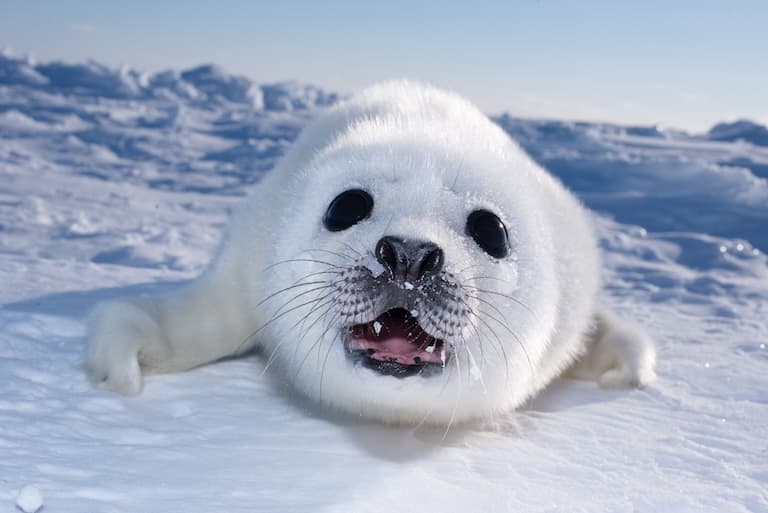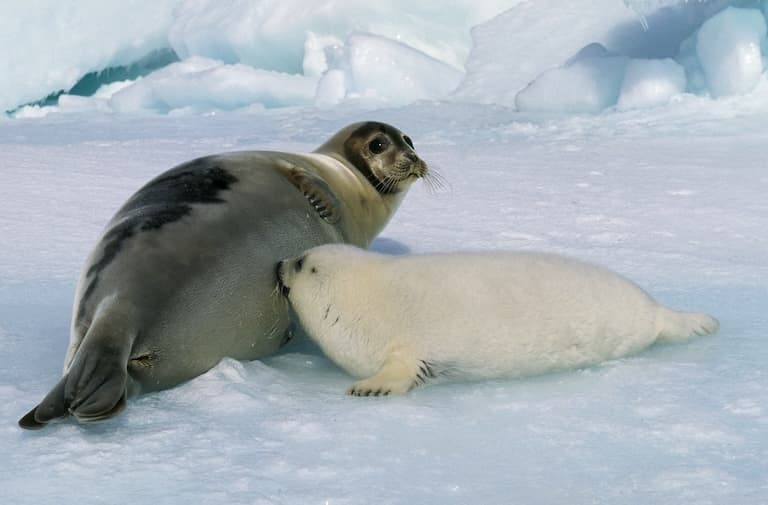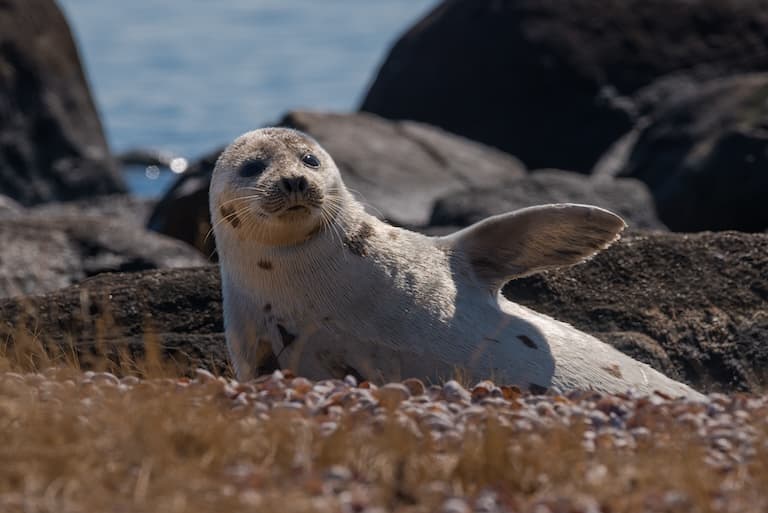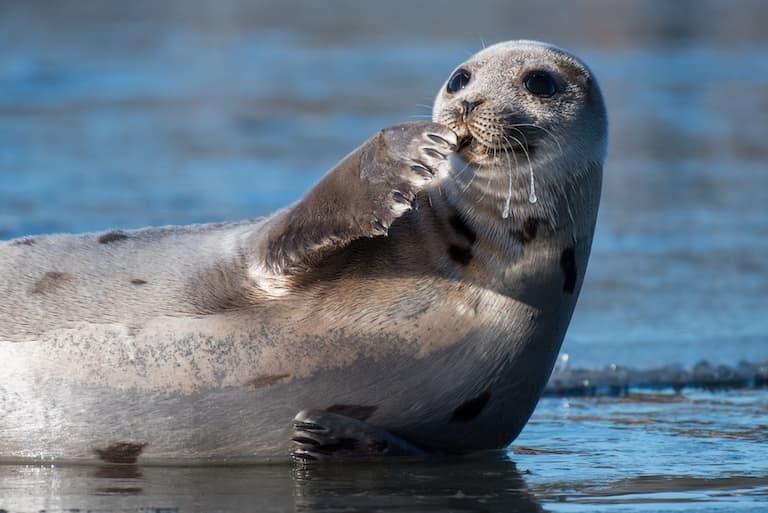Harp Seal Profile
We often take part in misguided attempts to make things better. It could be radical groups releasing captive animals, only for them to get diseased, shot, or starve for being in a place they aren’t fit to survive in; or bamboo toothbrushes, shipped using dirty diesel from the other side of the world to signal an “anti-plastic” virtue.
The story of the harp seal, though, is a refreshing case of mainstream attention actually making a difference.
And while there is some hypocrisy in protesting the quick death of a cute animal nobody eats while at the same time contributing a significant portion of the McDonald’s customer base, this shouldn’t detract from the success of the protest.

Harp Seal Facts Overview
| Habitat: | Marine, sea ice |
| Location: | Arctic regions: Greenland, Northern Scandinavia, Eastern Canada, Western Siberia |
| Lifespan: | More than 30 years |
| Size: | Up to 2m (6 ft 7 in) long |
| Weight: | Up to 140 kg (309 lb) |
| Colour: | Silver-grey with a large dark patch on the back |
| Diet: | Fish and invertebrates |
| Predators: | Polar Bears, Killer Whales and Greenland Sharks |
| Top Speed: | Unknown |
| No. of Species: | 1 |
| Conservation Status: | Least Concern (IUCN) |
Having been hunted for thousands of years, harp seals evolved with a healthy balance between native humans and their reproductive rates, but a sudden drive for their amazing fur pushed them to a tenth of their former glory.
Thankfully for the species, the hunting method was hard to watch, and the emotional response to these triggered widespread protests against the practice, and against fur in general.
Today, strict controls have seen their number skyrocket, past halfway back to their original population. And this is excellent news for an Arctic specialist who happens to also be super cute.
Interesting Harp Seal Facts
1. They migrate
For such slow animals, these seals sure do get around. Harp seals are strongly migratory, with some populations moving more than 4,600 km out of their breeding grounds. At least one individual was found in Norway, having been tagged in Nova Scotia, Canada.
This little guy was only 14 months old! 1
2. They’re generalist predators
Migrations like this would surely be harder if you were a fussy eater, and the harp seal most definitely is not.
When they’re young, harp seal pups eat invertebrates, mostly krill and amphipods, and the Greenland populations have a preference for crabs and cod.
Polar cod is a popular dish among most populations of harp seal, as is snailfish and skulpin, and the Newfoundlanders like a bit of herring, too. These seals are highly social and will forage together in large groups, their diet is made of a mix of over 67 species of fish and 70 invertebrate types.
Unlike most seals, this species doesn’t like to dive very far and spends most of its time foraging near the surface. 2
3. They’re fast ice breeders
This is true in more ways than one. “Fast ice” refers to the fixed sea ice, fastened to the coastline or the sea floor, that these seals spend much of their time on when they’re not in the water.
While it has nothing to do with speed, these seals do give birth quickly on the ice, and the whole process can happen in as little as 15 seconds. This sort of hurried approach reflects the extreme environment they’re breeding into, and the sense of urgency around adapting and surviving as quickly as possible.
In this instance, the urgency is a matter of energy preservation, something which continues well into the pup’s first few weeks.
After an enviable period of labour, the resulting product is painfully cute. 3

4. They’re fluffy
There are few things as adorable as a baby seal. They have all the triggering characteristics of a Disney character: big, helpless eyes, cute whiskered nose, a loving, yet vulnerable expression and a thick layer of inviting fluff that combine in us to release that universal involuntary noise we make in these situations.
Baby harp seals take this to the extreme because they live in some of the most extreme environments. They’re born bright white, and covered in Lanugo, which is a fancy word for baby fuzz. In these seals, this is dense and warm to make up for their lack of blubber, which they must store over time using their mother’s milk, which is up to 50% fat.
Mothers will lose more than 3kg of weight per day, feeding their fluffy offspring with enough fat to grow their blubber, and this is a necessary sacrifice, as it will be needed not only for warmth but for swimming.
Since this fur isn’t as waterproof and is not at all streamlined, they can’t swim yet, they just have to sit there. 4

5. Pups make their own cradles
Since they’re born on the ice, these pups don’t have a lot of nesting material available, so a simple fur coat and their body heat will have to do. While they’re busy growing their blubber layer, they conserve energy by being almost entirely immobile, soft little white fluffballs, stuck in one spot for weeks on end.
Over time, the small amount of body heat that does come out of them works to melt a little dent in the ice, and this forms a cradle, in which the pup will sit, even more protected from the elements, waiting for mum to return from her hunting expedition.
6. They’ve been hunted
The softness of these pups does not go unnoticed, and while their mothers are out hunting around 85% of the time, their vulnerability is clear. On the ice, polar bears are a serious threat, and the pups have merely the camouflage of their white coats to rely upon.
But it’s humans that cause the most damage. Around the turn of the ‘80s, and for many years following, seal clubbing became one of the hottest talking points between those with no personal incentive to take part and those financially invested in seal fur.
These cute little baby seals and their equally adorable parents were getting hammered in the face for fur in a bloody sacrifice to the gods of consumerism, and when news got out there was widespread public outcry.
Their populations tanked from around 9 million to just one, whacked over the head using an ancient native technique known as “clubbing”. The product at stake was a luxury fur bought by the wealthy, which for people who couldn’t afford it, seemed like an additional insult.
Critics of the practice cite all the same problems that arise relatively uncontested in the wider livestock farming industry: senseless brutality, failure to adhere to the killing regulations, botched jobs, and a subsequent surplus of suffering and gore.
Jaques Cousteau, the legendary marine biologist, commented:
“The harp seal question is entirely emotional. We have to be logical. We have to aim our activity first to the endangered species. Those who are moved by the plight of the harp seal could also be moved by the plight of the pig – the way they are slaughtered is horrible.”
But the public could still afford pork, so they mostly ignored him.
Still, while even today the hunting of harp seals continues into the hundreds of thousands, public outcry resulted in a much more controlled exploitation of the species, and the population is now on the rise and incredibly healthy. 5
7. They’re now on the rise
Tightly regulated seal hunting has resulted in a massive increase in harp seal populations, which are now thought to be in the realm of 5 million or so, and rising well. Hunting is also on the decline, but there are plenty of other things the species will have to worry about in the future.
These generalist predators will adapt to changes in diet well, but the reduction in fish species will eventually begin to take its toll. Further, the nets used to catch these fish are contributing to tens of thousands of harp seal deaths as bycatch for the industry.
Oil spills are another cause for concern, and there have been a handful of cases of these fluffballs getting coated in oil and unable to swim.
The heavy metals from industries that make their way into the oceans tend to accumulate in species at or near the top of the food chain, and harp seals have been found with dangerous levels of toxins in them. DDT is also present in higher quantities than the environment.
Finally, climate change threatens the very ice they breed on, and this change may happen rapidly as certain climate tipping points are reached.
But for now, and hopefully, for the foreseeable future, harp seals are a conservation success story and a rare happy ending as a result of widespread public action.

Harp Seal Fact-File Summary
Scientific Classification
| Kingdom: | Animalia |
| Phylum: | Chordata |
| Class: | Mammalia |
| Order: | Carnivora |
| Family: | Phocidae |
| Genus: | Pagophilus |
| Species: | Groenlandicus |
Fact Sources & References
- r: D. E. Sergeant (1973), “Transatlantic Migration of a Harp Seal, Pagophilus groenlandicus”, Canadian Science Publishing.
- “Harp Seal”, IUCN Red List.
- Anne Marie Helmenstine (2019), “Harp Seal Facts (Pagophilus groenlandicus)”, Thought Co.
- C Lydersen (1996), “Energetics of lactation in harp seals (Phoca groenlandica) from the Gulf of St. Lawrence, Canada”, PubMed.
- Brian Duignan, “The Canadian Seal Hunt”, Britannica.
